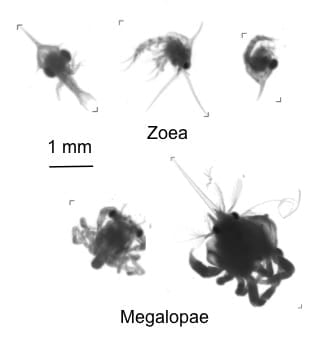Large, Shrimp-like Zooplankton


Here is a short video of large shrimp-like zooplankton you may see in your samples! See if you can find the mysid shrimp, copepods, crab zoea and megalopae.
Shrimp

Zooplankton collections often have small shrimp. Here in Delaware, there are two common types of small shrimp found in our waters. Decapod shrimp represent multiple species, most of which are larval forms of larger shrimp such as grass shrimp or sand shrimp. Mysid shrimp also represent multiple species who often live near the bottom of deeper waterways. Both are important food sources for a variety of coastal and estuarine fishes.
How can you tell the two apart? This can be difficult, but one of the easiest ways to tell the difference between mysids and decapods is to look at the carapace. The carapace of a mysid is only attached near the head, leaving the back portion flared and away from the body. They also have different shaped telsons (tails). Mysids usually have smaller, tapered telsons while decapod shrimp have ones that are larger, wider.
Amphipods

These small crustaceans are laterally compressed (lying on their sides) and lack carapaces. Most species are benthic, but some make short trips in the water column either by choice or by accident due to strong currents. Cerapus tubularis is easily identified by their house they carry with them. Others, like those in the genus Gammarus, do not have houses but are easily identfied by their laterally compressed bodies. Like, shrimp, they are also important food sources for small coastal and estuarine shrimp.
Crab Larvae
Most crabs, including blue crabs, spider crabs, and fiddler crabs, spend the early part of their life drifting around in the water as plankton. After hatching from eggs, they will first become zoea and spend most of their time in the upper reaches of the water column. As they grow, they eventual change into megalopae, looking more like their adult forms and make their way back to shallow, coastal areas. After that, they will shed their shells and grow until they become adults.

Summer zooplankton collections in Delaware often include zoea from multiple crab species.

